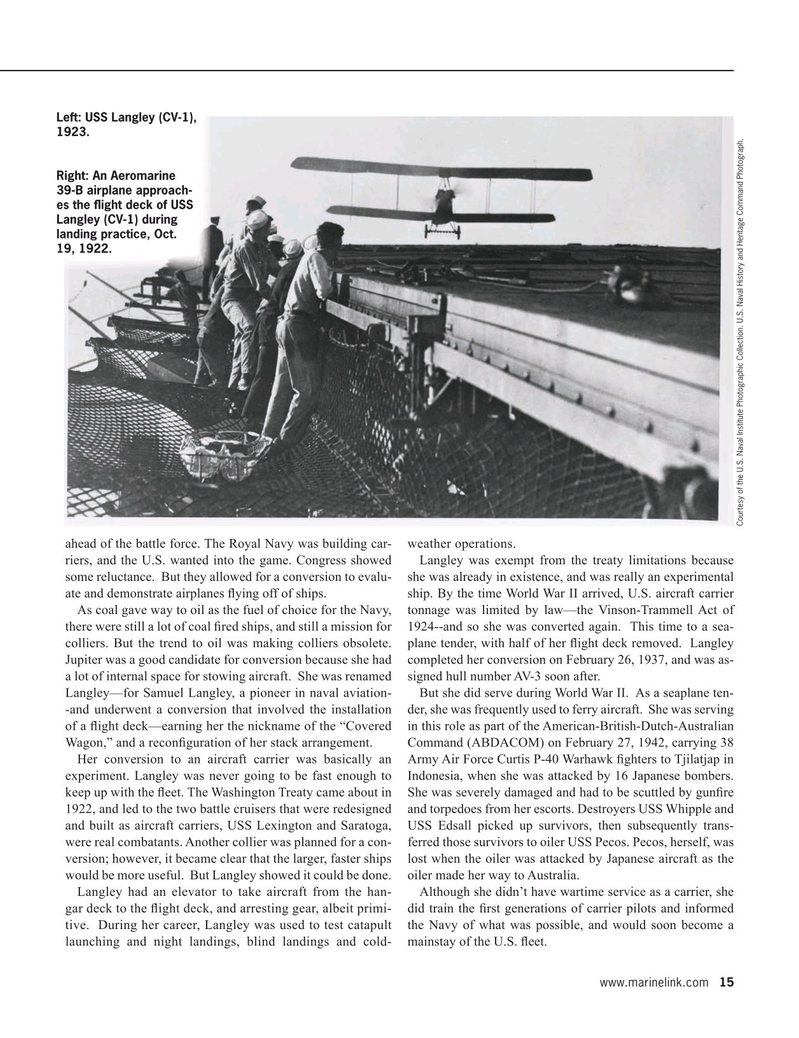
Page 15: of Maritime Reporter Magazine (December 2021)
Great Ships of 2021 Edition
Read this page in Pdf, Flash or Html5 edition of December 2021 Maritime Reporter Magazine
L Left: USS Langley (CV-1), eft: USS Langley (CV-1), 1 1923.
R Right: An Aeromarine 3 39-B airplane approach- e es s the ? ight deck of USS
L La angley (CV-1) during la landing practice, Oct.
1 1 19, , 1922.
Courtesy of the U.S. Naval Institute Photographic Collection. U.S. Naval History and Heritage Command Photograph.
ahead of the battle force. The Royal Navy was building car- weather operations.
riers, and the U.S. wanted into the game. Congress showed Langley was exempt from the treaty limitations because some reluctance. But they allowed for a conversion to evalu- she was already in existence, and was really an experimental ate and demonstrate airplanes ? ying off of ships. ship. By the time World War II arrived, U.S. aircraft carrier
As coal gave way to oil as the fuel of choice for the Navy, tonnage was limited by law—the Vinson-Trammell Act of there were still a lot of coal ? red ships, and still a mission for 1924--and so she was converted again. This time to a sea- colliers. But the trend to oil was making colliers obsolete. plane tender, with half of her ? ight deck removed. Langley
Jupiter was a good candidate for conversion because she had completed her conversion on February 26, 1937, and was as- a lot of internal space for stowing aircraft. She was renamed signed hull number AV-3 soon after.
Langley—for Samuel Langley, a pioneer in naval aviation- But she did serve during World War II. As a seaplane ten- -and underwent a conversion that involved the installation der, she was frequently used to ferry aircraft. She was serving of a ? ight deck—earning her the nickname of the “Covered in this role as part of the American-British-Dutch-Australian
Wagon,” and a recon? guration of her stack arrangement. Command (ABDACOM) on February 27, 1942, carrying 38
Her conversion to an aircraft carrier was basically an Army Air Force Curtis P-40 Warhawk ? ghters to Tjilatjap in experiment. Langley was never going to be fast enough to Indonesia, when she was attacked by 16 Japanese bombers. keep up with the ? eet. The Washington Treaty came about in She was severely damaged and had to be scuttled by gun? re 1922, and led to the two battle cruisers that were redesigned and torpedoes from her escorts. Destroyers USS Whipple and and built as aircraft carriers, USS Lexington and Saratoga, USS Edsall picked up survivors, then subsequently trans- were real combatants. Another collier was planned for a con- ferred those survivors to oiler USS Pecos. Pecos, herself, was version; however, it became clear that the larger, faster ships lost when the oiler was attacked by Japanese aircraft as the would be more useful. But Langley showed it could be done. oiler made her way to Australia.
Langley had an elevator to take aircraft from the han- Although she didn’t have wartime service as a carrier, she gar deck to the ? ight deck, and arresting gear, albeit primi- did train the ? rst generations of carrier pilots and informed tive. During her career, Langley was used to test catapult the Navy of what was possible, and would soon become a launching and night landings, blind landings and cold- mainstay of the U.S. ? eet.
www.marinelink.com 15
MR #12 (1-17).indd 15 12/2/2021 12:58:55 PM

 14
14

 16
16
